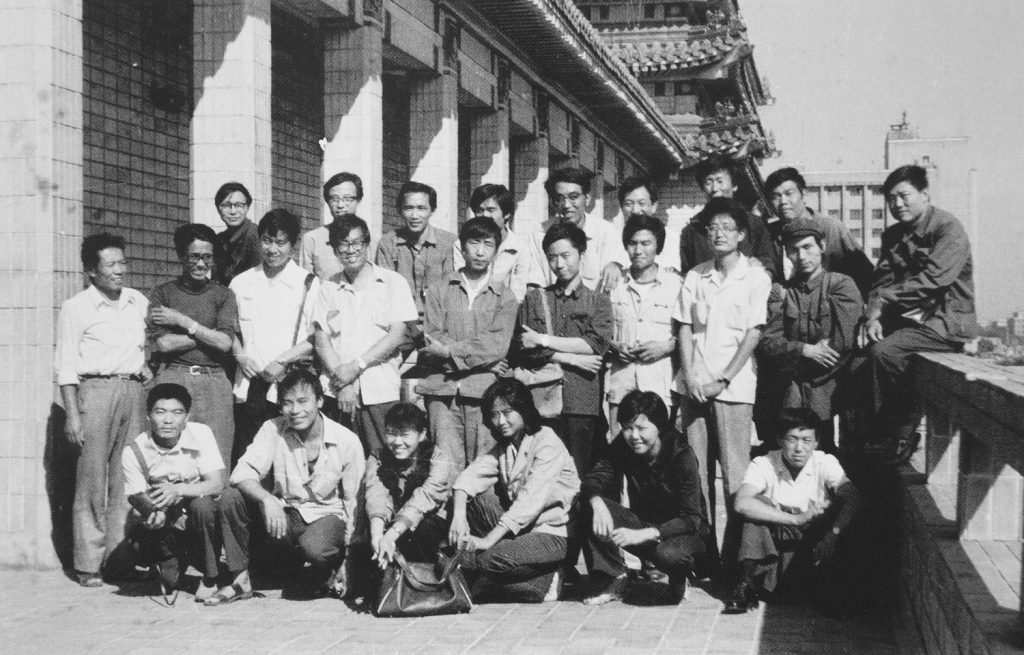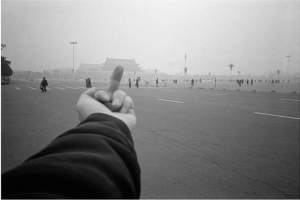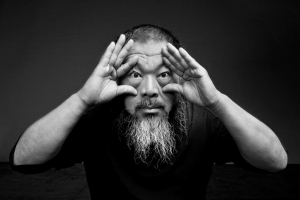“If my art has nothing to do with people’s pain and sorrow,
what is ‘art’ for?”
FROM THE BOTTOM UP
Before he could even speak, Ai Weiwei’s existence was a contentious one. At the age of one – the same year Mao’s ‘Great Leap Forward’ was suddenly halted by an economic catastrophe -Ai was interred in a labour camp with his family. His father, one of China’s leading poets at the time, had been denounced by the Chinese government, leading to their eventual exile.
This upbringing, as both a cultural insider and political outsider, shaped Ai’s future as an international social activist and figurehead for justice and free speech.
A LIGHT IN THE DARK
With the end of the Cultural Revolution, Ai and his family were able to return to Beijing.
Having developed an interest in art, he initially enrolled at the Beijing Film Academy, where he was classmates with some of China’s future leading directors, including Zhang Yimou.
However, Ai’s interest soon turned from film, and so he established an avant-garde art group called Stars. Now recognised as one of the progenitors of contemporary Chinese art, the group symbolised the resurrection of an artform that had been suppressed for decades, a shining light under the dark blanket of communist rule.
Mao’s death did not make it any easier for Chinese artists to have their voice heard, but nothing would deter Ai and his colleagues. When they were denied entry to their exhibition space, they hung their work on the railings outside the building, even when the government declared it illegal. When the police shut them down, they protested in the streets.
Jiang Feng, Chairman of the Artists’ Association, eventually allowed Stars to exhibit in the China Art Gallery. He expected the lack of interest would stifle the group’s revolutionary ideals.
200,000 visitors attended the attraction.

A NEW FRONTIER
In 1981, two years before Stars were forced to disband due to government pressure, Ai relocated to New York, where he would attend various schools for the next five years.
Starting in painting, then transitioning to sculpture, he eventually submerged himself in the conceptual art of Andy Warhol, Marcel Duchamp, and Jasper Johns, which would inspire much of his future work.
During this time, Ai took thousands of photos as he wandered through the city, which he would later convert into a book, and took such odd jobs as painting portraits for tourists in Times Square.
AN EXPLOSIVE RETURN TO CHINA
Just over a decade later, Ai returned to China to look after his sick father, and that’s where his true work began.
Ai co-published three books promoting avant-garde Chinese art. Published outside of official channels, these works helped raise the same awareness of China’s underground art community that he had started with Stars.
But it was in 2000, as Shanghai took its first foray into the world of contemporary art with the Shanghai Biennale, that Ai would present one of his most controversial and well known exhibitions.
Alongside the festival, in a nearby warehouse, Ai Weiwei showed Fuck Off. The exhibition was summarised by a collection of ‘first-person’ photos of Ai giving ‘the finger’ to the White House, the Forbidden City, and to the viewer themselves. Other elements included an artist undertaking a four-day fast, and a glass case filled with an animal skeleton and, apparently, enough poison gas to kill the entire audience.
Fuck Off was the evolution of the kind of work Ai had started with Stars 20 years earlier, and while many critics called the artists sensationalists, others revered their unique and creative approach.
The show, featuring raw work from 48 artists, was a battlecry aimed at censorship.
Ai Weiwei believes “maybe Fuck Off was most important because of what it represented…we had to say something as individual artists to the outside world, and what we said was ‘fuck off’.”

THE MOST POWERFUL ARTIST IN THE WORLD
Photography was just one of many art forms Ai excelled in. Having designed his own studio, Ai was well known as an architect, and was brought on to help design the Olympic Stadium for the 2008 Beijing Olympics.
While the opportunity helped get his name out to the broader international art community, and saw him soon receive the moniker ‘the most powerful artist in the world’, it would later be something which Ai regretted.
Ai was soon asked to be a guest blogger for one of China’s largest web companies. He used the blog as a platform for his criticism of the Chinese government.
Ai lambasted the Olympic Games as corrupt, comparing the stadium to a symbol of government propaganda.
He blamed government officials for allowing schools in the Sichuan province to be developed poorly, resulting in the death of over 5,000 schoolchildren during the 8.0-magnitude Sichuan earthquake.
His calls for a public investigation brought the ire of the government, who took action against him.
THE MOST DANGEROUS ARTIST IN THE WORLD
While some called him powerful, there were others who used another name for Ai Weiwei: China’s most dangerous man.
In 2009, he was beaten by police after coming forward to testify against the construction work and student casualties during the earthquake. He suffered a cerebral haemorrhage.
Two of his bank accounts were hacked in a sophisticated cyber-attack, leading to investigations by state agents.
2010 saw Ai placed under house arrest for attempting to dispute the demolition of his new Shanghai studio. While he was eventually released, and the studio seemingly saved, local government would demolish it two months later in a surprise move.
Most notably, Ai was arrested at an airport in 2011. He was placed in a secret prison for 81 days without charge, handcuffed to a chair, and interviewed around 50 times.
When he was eventually released, the Chinese government charged him with tax evasion. Even after his bail ended, he was prevented from travelling abroad.
NEVER SORRY
Even as Ai was forced to remain in China under heavy surveillance, his art travels the world. His work was shown in the UK, and at the renown San Franciscan prison of Alcatraz, he designed an installation supporting human rights in freedom of expression.
Ai stood strong, along with his supporters, who donated over 15 million yuan to pay his outstanding tax bill. When Lego refused to fulfil his order for a new exhibition, collection cars popped up at the National Gallery in Victoria, allowing people to donate boxes of the toy bricks. Nothing could keep him down.
In late 2015, Ai Weiwei was finally allowed a passport, and travelled to Melbourne for the opening of his latest exhibition: Andy Warhol | Ai Weiwei. He has also been traveling the world, hosting masterclasses in which he discusses both his life and work.
Ai’s history, in conjunction with his art, position him as one of the world’s most powerful artists, and rightly so. His opposition – whether they be the Chinese government or a Danish toy company – only serve to fuel his work, and remind audiences why people like Ai Weiwei are so important in ensuring a future for artists free of censorship and fear of reprisal.


This looks very promising. China needs more ouspotken celebrities who question the “prison” that governs their lives, in their homeland.VN:F [1.9.21_1169](from 0 votes)